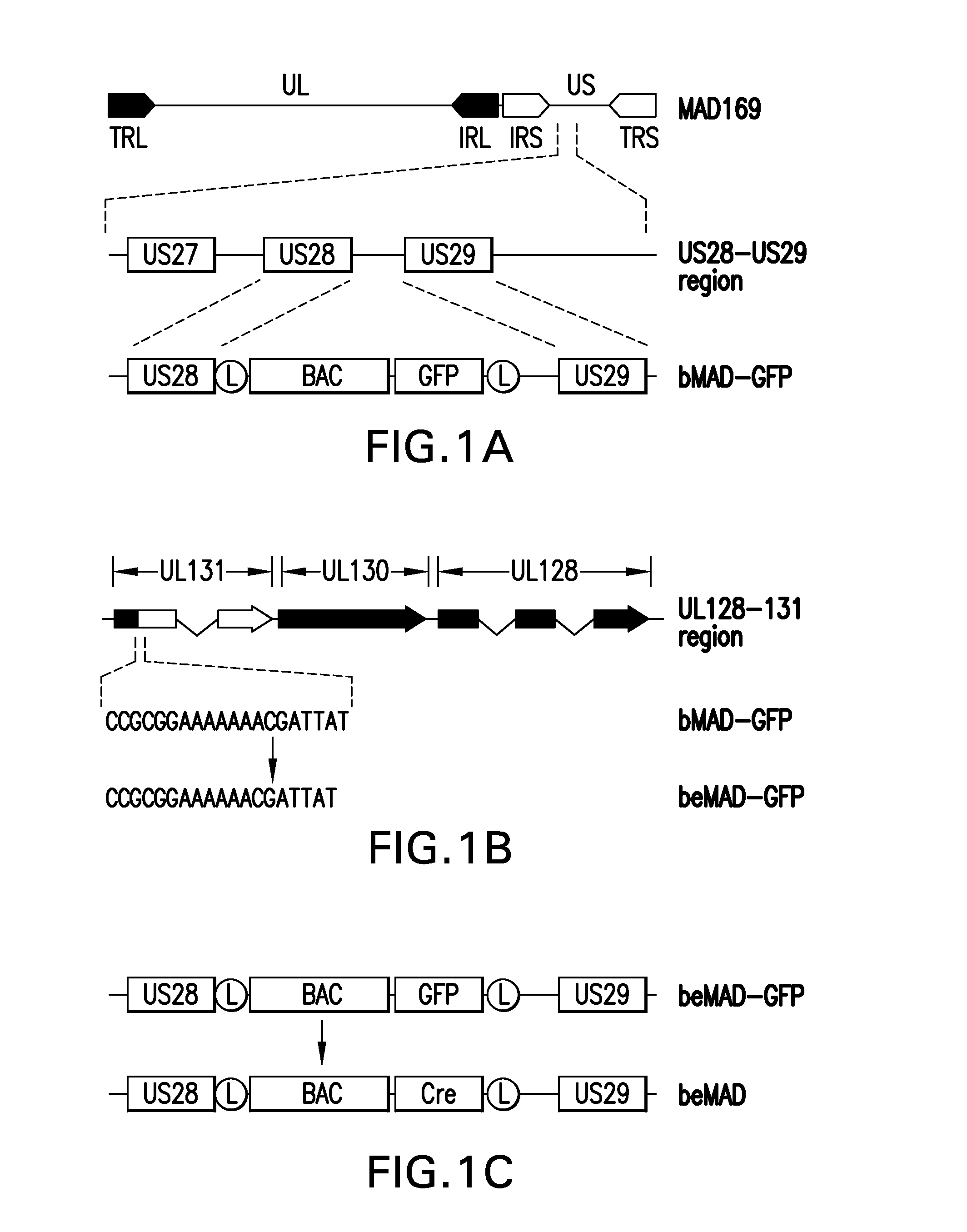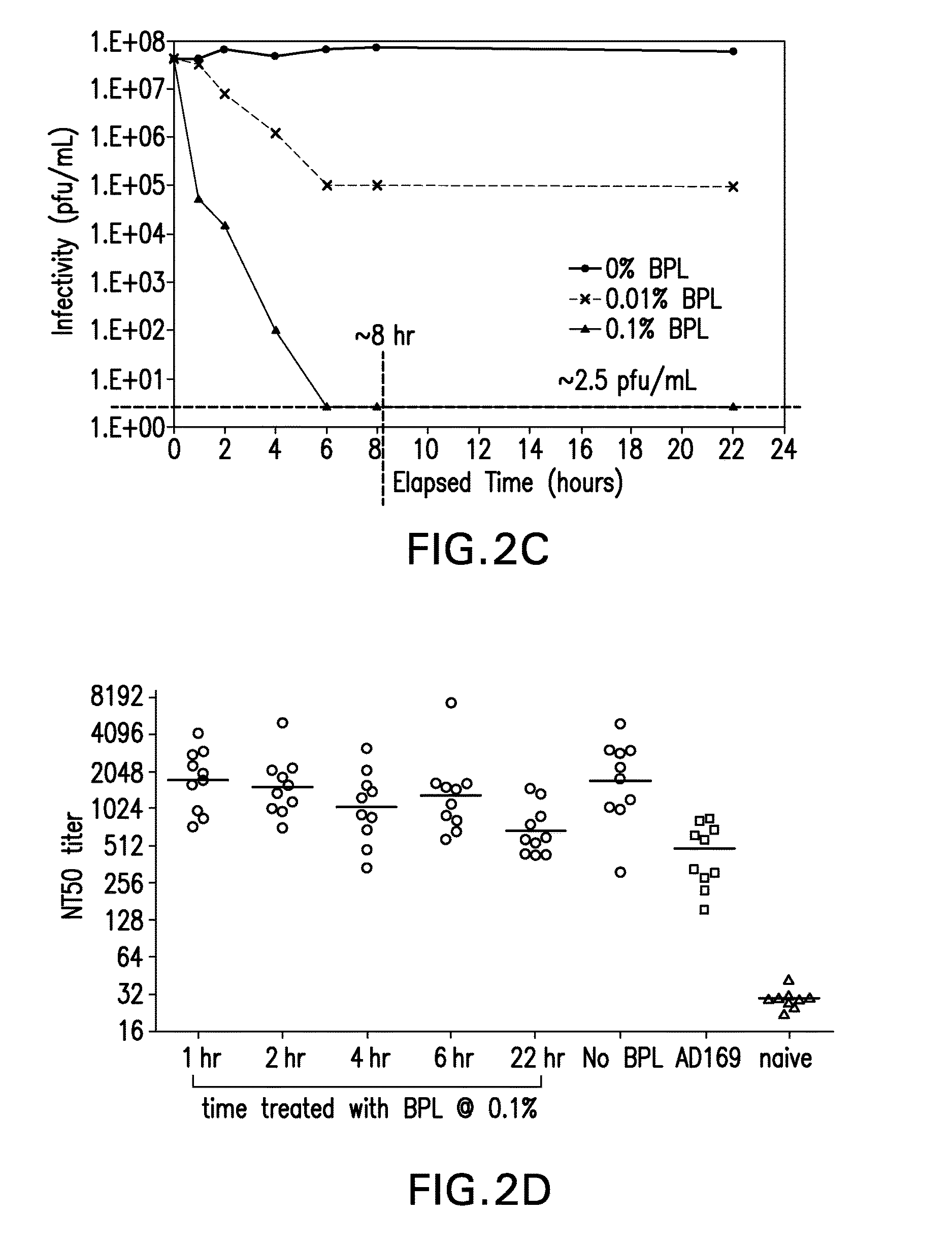Conditional replicating cytomegalovirus as a vaccine for CMV
a technology of cytomegalovirus and cytomegalovirus, which is applied in the field of conditional replicating cytomegalovirus as a vaccine for cmv, can solve the problems of cmv infections, people whose, and high fever, and achieve the effect of decreasing the likelihood of infection
- Summary
- Abstract
- Description
- Claims
- Application Information
AI Technical Summary
Benefits of technology
Problems solved by technology
Method used
Image
Examples
example 1
Restoration of the Pentameric gH Complex
[0111]An infectious CMV bacterial artificial chromosome clone was constructed so that the encoded virion that expressed the pentameric gH complex consisting of UL128, UL130 and UL131 assembled onto a gH / gL scaffold.
[0112]CMV strain AD169 strain was originally isolated from the adenoids of a 7-year-old girl (Elek and Stem, 1974, Lancet, 1:1). The virus was passed 58 times in several types of human fibroblasts to attenuate the virus (Neff et al, 1979, Proc Soc Exp Biol Med, 160:32, with the last 5 passages in WI-38 human fibroblasts. This passaged variant of AD169 virus, referred in this study as Merck AD169 (MAD169), was used as the parental virus to construct the infectious BAC clone. Neither the parental virus AD169 nor the passaged variant virus MAD169 expressed UL131 or the pentameric gH complex.
[0113]The MAD169 was used as the parental virus to construct an infectious bacterial artificial chromosome (BAC) clone. A BAC vector is a molecular...
example 2
Effect of Conventional Inactivation Methods on gH Complex
[0117]The effect of two conventional methods of viral inactivation, γ-irradiation and β-Propiolactone (BPL), were investigated on the CMV expressing gH.
[0118]The γ-irradiation was performed on lyophilized virions. Recombinant CMV vaccine at a concentration of 0.15 mg / mL in FINS (25 mM Histidine, 150 mM NaCl, 9% w / v Sucrose, pH 6.0) formulation was lyophilized using a conservative lyophilization cycle (−50° C. freezing and primary drying at −35° C. for ˜30 hrs followed by secondary drying at 25° C. for 6 hrs) to obtain dry powder. The vaccine was lyophilized in a 3 mL glass vial with 0.5 ml filled in each vial. At the end of lyophilization, the vials were stoppered in a nitrogen environment and the samples were removed, labelled, crimped and stored at −70° C. until gamma irradiation. The vials were irradiated under a Co irradiator for the desired dosage of irradiation.
[0119]For BPL treatment, a BPL stock solution was added to t...
example 3
Construction and Screening of FKBP-Essential Protein Fusions
[0122]A CMV was constructed using the attenuated AD169 strain backbone that regains its epithelial tropism while being conditionally replication defective. Methods described in Example 1 were used to restore epithelial tropism.
[0123]The viral proteins to be fused to the FKBP derivative were selected based on two criteria. First, the proteins of interest were not detected in CMV virions by proteomics analysis (Varnum et al., 2004, J. Virol. 78:10960), thus, decreasing the likelihood that the FKBP fusion protein will be incorporated into virus. Second, the proteins of interest are essential for viral replication in tissue culture.
[0124]Using beMAD as the parental virus, the FKBP derivative (SEQ ID NO:12) was fused to 12 essential viral proteins individually, including IE1 / 2 (SEQ ID NO:1), pUL37×1, pUL44, pUL51 (SEQ ID NO:3), pUL52 (SEQ ID NO:5), pUL53, pUL56, pUL77, pUL79 (SEQ ID NO:7), pUL84 (SEQ ID NO:9), pUL87 and pUL105. ...
PUM
| Property | Measurement | Unit |
|---|---|---|
| molar concentration | aaaaa | aaaaa |
| molar concentration | aaaaa | aaaaa |
| diameter | aaaaa | aaaaa |
Abstract
Description
Claims
Application Information
 Login to View More
Login to View More - R&D
- Intellectual Property
- Life Sciences
- Materials
- Tech Scout
- Unparalleled Data Quality
- Higher Quality Content
- 60% Fewer Hallucinations
Browse by: Latest US Patents, China's latest patents, Technical Efficacy Thesaurus, Application Domain, Technology Topic, Popular Technical Reports.
© 2025 PatSnap. All rights reserved.Legal|Privacy policy|Modern Slavery Act Transparency Statement|Sitemap|About US| Contact US: help@patsnap.com



